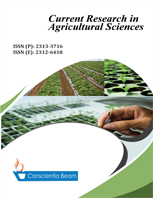Growth and Yield Response of Shallot (Allium cepa var. aggregatum) Varieties to Intra-Row Spacing in Eastern Amhara, Ethiopia
DOI:
https://doi.org/10.18488/journal.68.2019.62.157.168Abstract
Shallot is an important crop as a condiment as well as a source of income for smallholder farmers in Ethiopia. However, the yield of the crop is constrained by a number of factors among which inappropriate plant spacing and lack of improved varieties are the bottlenecks of its productivity in the study area. Therefore, a field experiment was conducted at Densa, Eastern Amhara, and Ethiopia to evaluate the growth and yield response of shallot varieties to intra-row spacing. The treatments consisted of four intra-row spacings (5, 10, 15 and 20 cm) and three shallot varieties (Dz-sht-157-1B, Dz-sht-91-2B, and Yheras). These were laid out in randomized complete block design replicated three times. Data on growth and yield parameters were recorded and subjected to analysis of variance (ANOVA). Results indicated that varying intra-row spacings from 5 to 20 cm increased significantly (P <0.01) all yield characters assessed in all the traits except cured bulb yield (t ha-1) which decreased as a result of increasing intra-row spacing from 5 to 20 cm. Highest total bulb yield (26.20 t ha-1) and marketable bulb yields (25.24 t ha-1) were recorded at the closest intra-row spacing (5 cm). Dz-sht-157-1B variety was superior in terms of leaf number per plant (35.82), average bulb weight (69.08 g), marketable yield (24.46 t ha-1) and total bulb yield (25.17 t ha-1). Hence, based on the result, Dz-sht-91-2B grown at 10 cm intra-row spacing should be adopted by farmers in study area. However, further investigations on multiplications and over years should be made to come up with complete recommendations.

